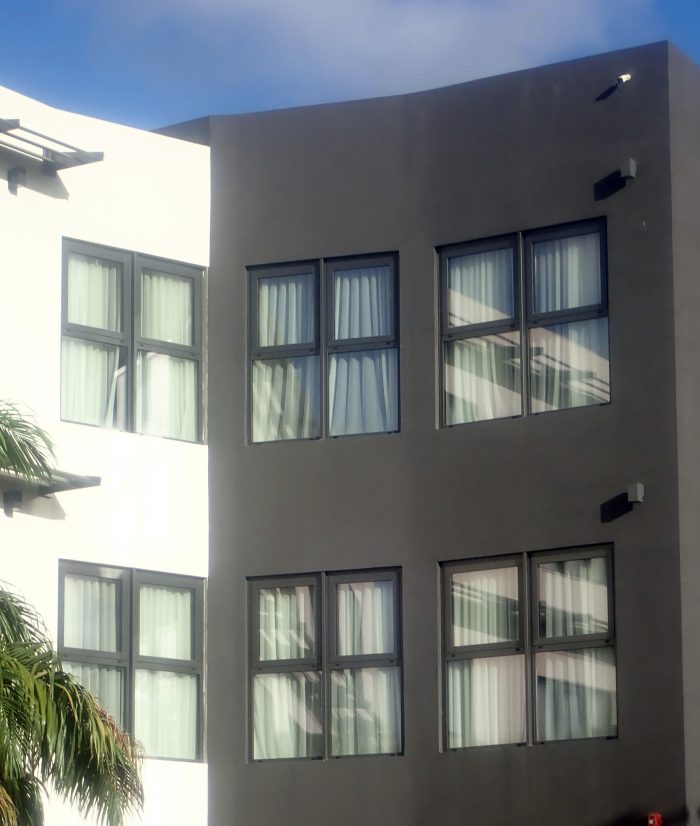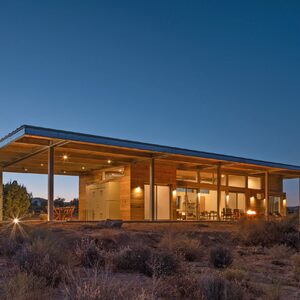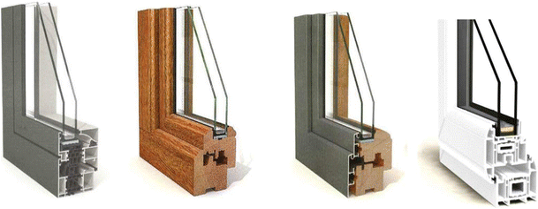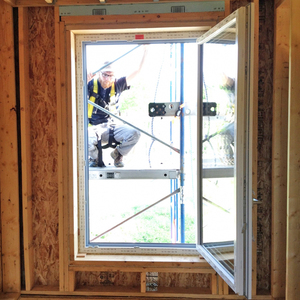
One of the most common errors made by designers of hot-climate homes is to include too many unshaded windows. Here’s a fun game for residents of Texas or Florida: drive around a residential neighborhood on a sunny day and look for windows exposed to sunlight. There are lots of them, right? The next thing you’ll notice is that almost every one of these windows is made opaque by interior curtains or blinds, so the residents can’t see through them. You’ll see some homes with six or more windows exposed to the sun—every one of which is blocked by blinds or curtains.

There are two main reasons for all these blinds: glare and excessive heat gain.
I live in Vermont, where window blinds are far less common than they are in Texas. Unless they have nearby neighbors who like to snoop, Vermonters don’t have much need for blinds. If the sun wants to shine through our windows, that’s fine with us. We almost always appreciate the heat.
Windows should be transparent
A well-designed window provides a view of the outdoors and allows natural light into our homes. But if a window is completely sealed off by window blinds for most of the year, it’s not doing the homeowner much good. It might as well be filled with studs, insulation, and drywall. A window that is perpetually covered with blinds represents a design failure.
At this high-rise residential property, the sliding glass doors on the balconies at the left side of the photo mostly have the curtains open. The blinds on the unshaded windows on the right, however, are all down. [Photo credit: Martin Holladay]It seems to…
Weekly Newsletter
Get building science and energy efficiency advice, plus special offers, in your inbox.

This article is only available to GBA Prime Members
Sign up for a free trial and get instant access to this article as well as GBA’s complete library of premium articles and construction details.
Start Free TrialAlready a member? Log in















13 Comments
A very common workaround to insufficient overhangs here in Phoenix AZ is solar screens or solar shades. The windows look like black voids from the street. They are notably more effective than blinds since they block quite a bit of the sun before it gets into the window in the first place. They block a lot of the visible light as well but not all of it, so you can see through them from the inside looking out (just like through sunglasses).
We had them in our previous "new" home, which had minimal overhangs and yeah, they absolutely do work and are far better than using blinds in nearly every way.
That said, when we moved, we specifically looked for homes with massive overhangs so we wouldn't have to apply a workaround like that in the first place!
A completely horizontal Brise Soleil is very effective too.
Malcolm,
Thanks. For those unfamiliar with the term, a brise soleil (French for "sun breaker") is an exterior shading device, usually louvered, to protect windows from the sun. The photo below comes from Wikipedia.
One of the photos I chose to include in this article (the photo directly above the sentence, "The best solutions are exterior solutions like awnings or exterior shade features") is a type of brise soleil (although clearly not a horizontal example). Architects can design a brise soleil to be horizonal, sloped, or adjustable.
"Vermonters don’t have much need for blinds." Agree with the idea that solar gains are welcome in northern locations during wintertime (which is 90% of the year in Vermont?? ;-)
More seriously, in frigid December and January when the sun only shines for about one third of the day in northern climates...During the nighttime (two-thirds of the Day in December and January), cellular shades with side tracks, window quilts, and reasonably airtight insulated shutters can double the effective R-value (halve the U-factor) of windows, at a lower cost than upgrading the window, even in new construction. (Interior window coverings need to be fairly airtight to avoid convection currents, condensation and icing.). Clear plastic window insulation kits or interior glass window inserts can add a third "pane" to help too. As Martin points out, windows lose and gain A LOT of heat compared to walls, typically 5 to 10 times as much per area. Not to mention being more expensive during construction than wall space, in both materials and labor.
Also agree with the window shading suggestions. One more: A deciduous shade tree strategically located a little bit north of west of windows is another way to provide summer shading without blocking the view very much. The summer sun sets in the west, but a little north of west. The winter sun is a bit south of west, and deciduous trees will have no leaves during winter, allowing more sun to shine on the west side of the house during afternoons. (Similar for morning sunlight on the east side of the house.)
Note that SOUTH-facing windows typically GAIN more solar heat in December and January than the BTUs they lose, assuming they are not shaded midday by another building, tree or other obstruction. For details see Table 2 in:
https://www.greenbuildingadvisor.com/article/a-quantitative-look-at-solar-heat-gain
Robert,
Cellular shades and window quilts will, indeed, reduce nighttime heat loss through windows in cold climates. While these solutions may be less expensive than window replacement, they are so expensive that energy savings will never pay for the cost of installing them.
Although these shades and quilts aren't cost-effective (in terms of energy savings), many people are willing to make the investment to improve comfort. For more information, see these two articles:
"What Should I Do With My Old Windows?"
"Insulating Window Shades"
Martin,
We have cellular shades on anderson casement windows, and though I can't be bothered to do the math on payback, they make a huge difference in comfort. Enough so it seems like they have to be saving a measurable amount of energy..
I don't remember the brand, but they are 20ish years old, and other than having to replace the draw strings a time or two, still going strong.
If cost-justification is your goal, then home-made shutters can be a good choice. EPS or polyiso isn't expensive compared to most window coverings. Some 1x2's and screws for a rectangular frame, and some cloth covering for the interior side, stapled around the frame, and an hour's worth of labor, and you've got R-5 to R-8 vs. whatever alternative window covering available at your preferred retailer. You can even use both inside mount shades year-round, and shutters over the windows during the worst winter weather. Shutters can be designed to operate by pop-in window frame, hang over window frame, hinged to the window trim sides or wall, etc. Storing them when not in use can be an issue, if they aren't hinged to the sides of the window. Changing the cloth covering is easy if you want a style change, or if you want to mount photos or artwork instead of a cloth cover. People who visited my house thought the "hang over the window trim" large window shutter was wall hanging artwork, not realizing it was covering a window. The pop-in shutters were hidden behind the cellular shades, in the deep window wells, so they were not visible on the interior.
So Martin, what window coverings do you use in your home in northern Vermont?
Robert,
I have a commercial window quilt (with relatively airtight side tracks and a velcro seal at the window stool) in our cold downstairs bathroom. Every other window in the house stays transparent, night and day.
Most homeowners get tired of the twice-a-day chore of installing and removing insulating shutters -- and they are, indeed, a pain to store or look at when not in use.
Having just helped my 30-something nephews wire their new house with all smart switches because it's too much effort to wander over to a wall, I suspect the days of manually placed window coverings are limited by rapidly changing demographics.
Eloquent
Perhaps I missed mention of the louvered shutter, the 19th c. solution? Before air-conditioning, shutters were a necessary part of a window assembly. Double hung windows were left open during the heat of the day - louvered shutters allow outside air to flow through them while keeping bugs at bay and reducing the heat and bleaching affects of the sun. Now we keep our windows permanently shut with AC running. Could a motorized automated shutter be used to close shutters on timers?
Motorized shutters are readily available, and can be put on timers or fancier home automation systems. External motorized shutters are more common in Europe than North America but they can be found here as well.
Given the alternatives I'm not sure shutters would be my first choice. Either overhangs or Blise Soleil offer a permanent solution that doesn't need adjusting. If you want something mechanized I'd probably go for awnings, which don't impede light, views or airflow.
Log in or become a member to post a comment.
Sign up Log in